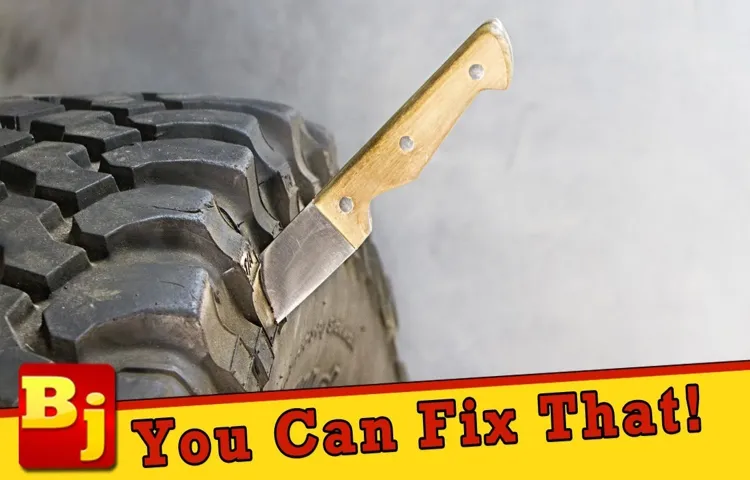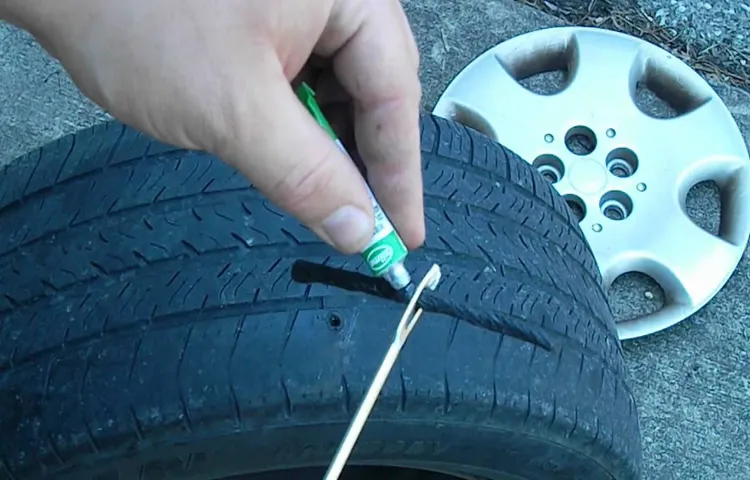Flat tires are an inevitable part of driving, and unfortunately, they can happen to anyone, anywhere. Whether it’s a slow leak or a sudden blowout, a flat tire can be a major inconvenience and expense. One of the most common concerns when it comes to tire repairs is how much it will cost.
The answer, as with most things, is that it depends. The cost of a tire repair can vary greatly depending on several factors, such as the type of tire, the severity of the damage, and where you take your vehicle for repairs. While the cost of a tire repair may seem daunting, it’s important to remember that it’s an investment in your safety and the longevity of your vehicle.
Driving on a flat tire can cause serious damage to your rims, suspension, and even your steering system. It’s best to address any tire issues promptly to avoid further damage and potentially more expensive repairs down the road. In this article, we’ll take a closer look at the various factors that can impact tire repair costs and give you a better idea of what to expect.
We’ll also provide some tips on how to avoid flat tires in the first place and how to handle an unexpected flat tire on the road. So, buckle up and let’s dive into the world of tire repair costs!
Table of Contents
Factors Affecting Tire Repair Cost
If you’re wondering how much it costs to fix a tire, there are several factors that come into play. One of the major factors is the type of damage your tire has sustained. A small puncture or nail in the tread can usually be easily repaired with a patch or plug for a low cost.
However, if the damage is more severe, such as a sidewall puncture or a large tear, you may need to replace the tire entirely, which can be much more expensive. Additionally, the age and condition of the tire can affect the cost of repair. Old tires or ones that have uneven wear may require additional work or replacement.
Finally, the cost of repairing a tire may vary depending on where you go. Different shops or mechanics may charge different rates, so it’s important to shop around and get multiple quotes before making a decision. Overall, the cost of repairing a tire can range from a few dollars to hundreds of dollars, depending on various factors, but it’s always better to have it checked rather than risking a blowout on the road.
Type of Tire Damage
When it comes to repairing tires, various factors can impact the cost of fixing them. One of the crucial determinants is the type of damage that the tires have sustained. The extent of the injury includes punctures, cuts, and abrasions that indicate the tire’s ability to be repaired or replaced.
For instance, if the tire has a puncture on the treads, the repair cost may be relatively lower since the repair can be done without replacing the tire. Additionally, the tire’s size, performance rating, and manufacturing type are other factors that can affect repair costs. If your tire has suffered extensive damage or is a high-performance tire, the cost of repair may be significantly higher.
Generally, to assess the amount you will pay to repair your tire, it is best to consult a professional to determine the best course of action for your specific situation. Overall, paying attention to your tire’s condition and addressing any damages promptly can save you money in the long run and promote road safety.

Tire Size
When it comes to repairing or replacing tires, there are several factors that can affect the cost. One of the main factors is the size of the tire. The larger the tire, the more expensive it tends to be to replace or repair.
This is because larger tires require more material for manufacturing and can be more difficult to work with. Additionally, larger tires are often used on vehicles that are heavier or more specialized, which can impact the overall cost. However, smaller tires can also be expensive to repair or replace if they are for a unique or specialized vehicle.
Ultimately, the cost of tire repair or replacement will depend on a variety of factors beyond just the size, including the condition of the tire, the type of tire, and the type of repair needed. By understanding these factors, you can better anticipate the cost of tire repair and make informed decisions about how to proceed with your vehicle’s maintenance.
Tire Brand
When it comes to repairing tires, there are several factors that can affect the cost, such as the type of tire brand. Some tire brands are more expensive than others, making it pricier to repair or replace them. Furthermore, the size and age of the tire can also play a significant role in repair costs.
Older tires may require more extensive repairs or even replacement, which can increase the cost. The location of the damage on the tire can also influence the overall cost, as certain areas may be easier or more difficult to repair. To prevent costly tire repairs, it is essential to maintain and inspect your tires regularly to address any damage or wear before it becomes a more significant issue.
Overall, the cost of tire repair can vary depending on several factors, but with proper maintenance and care, it is possible to keep these costs manageable over time.
Cost of Common Tire Repairs
If you’re wondering “how much to fix a tire?” it really depends on the type of repair needed. A simple puncture or nail in the tire can usually be patched up for around $20 to $30, but if the tire is worn or has a more serious issue like a sidewall bulge, it may need to be replaced, which can run you upwards of $100 or more depending on the make and model of your car. Tire rotations and balancing can also add up, with prices typically ranging from $40 to $80.
It’s always a good idea to get an estimate from a reputable mechanic or tire shop so you have a better idea of how much the repairs will cost before proceeding with any work. It’s important to keep in mind that proper tire maintenance, like regular rotations and inflation checks, can help prevent costly repairs in the long run.
Puncture Repair
Puncture Repair When it comes to flat tires, it’s important to know the cost of common tire repairs, so you can be prepared for unexpected expenses. One of the most common tire repairs is puncture repair, which can range in cost depending on the severity of the damage. For minor punctures, such as those caused by a nail or screw, the repair cost can be relatively low, averaging between $10-$20.
However, if the puncture is larger or located in the sidewall, the tire may need to be replaced entirely, which can cost significantly more. It’s also important to consider the cost of the labor involved in the repair process, as well as any additional fees that may be charged. Overall, the cost of puncture repair can vary, but it’s best to have a rough idea of the potential costs before heading to the tire shop.
Tire Patch and Plug
When it comes to tire repairs, one of the most common methods used by mechanics is the tire patch and plug. This process involves removing any objects that have punctured the tire, using a patch to cover the hole from the inside, and then using a plug to fill in the hole on the tread. This is a cost-effective and long-lasting solution that can be done quickly if you have a flat tire.
However, the cost of this repair can vary depending on the type of tire and the size of the puncture. A small puncture can cost around $20 to $30 to repair, while a larger one can cost up to $80 or more. Keep in mind that some tire repair shops may offer additional services, such as balancing and alignment, which can also contribute to the overall cost.
It’s essential to consider all of these factors when determining the cost of tire repair. Overall, a tire patch and plug is an excellent option for fixing most punctures, but it’s crucial to have a professional assess the damage and provide an estimate before proceeding with any repairs.
Tire Replacement
When it comes to tire repairs, the cost can vary depending on the type of repair needed. In general, the cost of a simple patch or plug typically ranges from $10 to $30. However, if the damage is more severe, such as a sidewall puncture or a tire blowout, the cost of replacement can be much higher, often ranging between $100 and $300 per tire.
It’s important to know when to replace your tires, as driving on worn-out tires can be dangerous. A good rule of thumb is to replace your tires when the tread depth reaches 2/32 of an inch or less. Additionally, if you notice any bulges, cracks, or other visible signs of damage, it’s best to have your tires checked by a professional.
Investing in high-quality tires and regular maintenance can help extend the lifespan of your tires, potentially saving you money in the long run. So, don’t skimp on tire repairs or replacements; your safety is worth it.
How to Avoid Tire Damage and Repair Costs
Tire damage is not only inconvenient but can also be costly. It’s important to take preventive measures to avoid tire damage and repair costs. Firstly, ensure that your tires are properly inflated and check them regularly.
Under-inflated tires can cause excessive wear and tear and can be dangerous, as they heat up quickly and may lead to a blowout. Secondly, be cautious when driving in hazardous or rough road conditions. Potholes, sharp objects, and debris can cause punctures or tears in your tires.
Thirdly, maintain good driving habits by not swerving suddenly or driving in a way that puts excessive strain on your tires. If you do experience tire damage, it’s important to have it fixed as soon as possible. The cost to repair a tire can vary depending on the extent of the damage, but it’s generally cheaper to fix it earlier rather than later.
In most cases, a simple patch or plug can be used to repair minor damage. However, if the damage is too severe, you may need to replace the entire tire, which can be considerably more expensive. Overall, taking care of your tires and addressing any damage promptly can save you a lot of money and hassle in the long run.
Proper Tire Inflation
Proper tire inflation is essential if you want to avoid costly repairs and ensure your safety on the road. Underinflation can cause your vehicle to consume more fuel, while overinflation increases your risk of a potential blowout. To check the proper tire pressure, you can refer to your vehicle’s owner manual or the label on the driver’s side doorjamb.
Make sure you use a tire pressure gauge to ensure that each tire has the right pressure level. For best results, measure tire pressure when your tires are cold as the heat of driving can increase the reading. Inflation levels can change with the time and the temperature outside.
It’s important to check your tires at least once a month or before starting a long trip. Proper tire inflation is a simple and easy way to keep your car in top condition and protect yourself while driving. Remember, a small investment of time to check your tire pressure can save you from potential repair expenses and even hazards on the road.
Regular Tire Inspections
Regular tire inspections are critical for avoiding tire damage and repair costs. Your tires are the only point of contact between your vehicle and the road, which is why they play a crucial role in ensuring your safety on the road. Some drivers make the mistake of neglecting their tires until a serious problem arises.
Regular inspections, however, can help you detect issues early on and address them promptly. Checking for proper tire pressure, tread depth, and signs of wear and tear should be part of your routine maintenance. With regular inspections, you can avoid the costly and hassle of unexpected tire damage and repairs.
Don’t forget, your tires are the foundation of your vehicle’s safety, and you wouldn’t want to compromise that for any reason.
Conclusion
In summary, the cost of fixing a tire can vary depending on a number of factors such as the severity of the damage, the type of tire, and the location of the repair shop. One thing is for sure, however: attempting to fix the tire yourself with duct tape and a prayer is not advisable. So, when in doubt, leave it to the professionals and be prepared for a moderate expense.
Remember, the inflated cost of a new tire is far worse than the deflated cost of a repair.”
FAQs
What is the average cost to fix a tire?
The average cost to fix a tire can vary depending on the type of tire and the extent of the damage, but it typically ranges from $20 to $40.
Can a tire be fixed or does it need to be replaced?
In some cases, a tire can be fixed if the damage is minor and located on the tread area. However, if the damage is on the sidewall or if there is significant damage to the tread, the tire will need to be replaced.
Is it safe to drive on a tire that needs to be fixed?
It is not recommended to drive on a tire that needs to be fixed or replaced as it can be a safety hazard. The damaged tire can lead to a blowout, loss of control, and potentially cause an accident.
How often should I check my tires for damage?
It is recommended to check your tires for damage at least once a month. This can help you catch any issues early on and prevent them from becoming worse.
What are some common causes of tire damage?
Some common causes of tire damage include hitting potholes or curbs, driving on underinflated tires, overloading the vehicle, and driving on rough roads.
Can I fix a tire myself or do I need to take it to a professional?
While it is possible to patch or repair a tire yourself, it is recommended to take it to a professional to ensure it is done correctly and safely.
Is it worth buying a tire protection plan or warranty?
Purchasing a tire protection plan or warranty can provide peace of mind and potentially save you money in the long run if you encounter any tire issues. However, it ultimately depends on your individual needs and budget.



